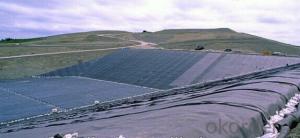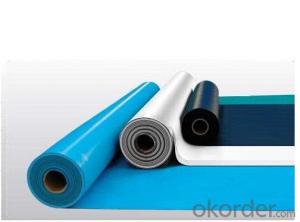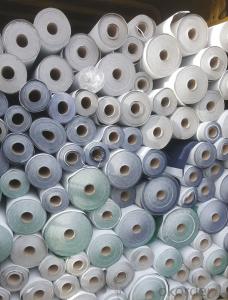Polymer(SBS)modified bituminous waterproofing sheet of resistance to root penetration
- Loading Port:
- China main port
- Payment Terms:
- TT OR LC
- Min Order Qty:
- 10 m²
- Supply Capability:
- 800000 m²/month
- Option:
- 1m*10m
OKorder Service Pledge
OKorder Financial Service
You Might Also Like
Item specifice
01 Product introduction Product Introduction
Jiuyang waterproof polymer modified asphalt root puncture waterproof reel is made of long fiber polyester felt or special composite copper tire base as the reel tire base, SBS modified asphalt with imported chemical root blocking agent as the coating material, and polyethylene film, fine sand or mineral particles as the isolation material on both sides. It has good puncture resistance, strong adhesion, good stability, low temperature flexibility and good heat resistance, reflecting excellent resistance and waterproof performance.
02 Product characteristics
1. It has the dual function of waterproof and preventing plant root penetration, and can withstand plant root puncture and maintain waterproof function for a long time.
2. It prevents root puncture and does not affect the normal growth of plants.
3. It can form a high-strength waterproof layer, strong resistance to water pressure, and resistant to puncture, rupture and tear.
4. High tensile strength, large thickness of modified asphalt coating layer, strong adaptability to base shrinkage deformation and cracking.
5. Excellent high and low temperature resistance, suitable for both hot and cold areas.
6. Corrosion resistance, mold resistance, good weather resistance.
7. Hot melt construction, convenient construction and hot joint reliable and durable.
03 Applicable scope
Suitable for planting roofs and the roof of underground buildings that need greening, the plant root puncture resistant layer ensures that the plant root system does not damage the structure below this level, and has waterproof function.
04 Packaging and storage andtransportation
1. When storing and transporting, different types and specifications of products should be stacked separately and should not be mixed. Avoid sun and rain, pay attention to ventilation, away from fire.
2. Storage temperature should not be higher than 50℃, vertical storage can only be single layer, and neutral storage should not exceed two layers during transportation.
3. Prevent tilt or side pressure during transportation, and cover the tarpaulin if necessary.
4. Under normal transportation and storage conditions, the storage period is 1 year from the date of production.
- Q:Can a waterproofing membrane be used on precast cement board surfaces?
- Yes, a waterproofing membrane can be used on precast cement board surfaces. The membrane acts as a protective barrier against water infiltration and helps to prevent damage to the cement board.
- Q:Can a waterproofing membrane be used for plant rooms and mechanical equipment areas?
- Plant rooms and mechanical equipment areas can benefit from the use of a waterproofing membrane. It is necessary to waterproof these areas in order to safeguard the equipment and surrounding structures against water damage. A waterproofing membrane serves as a commonly implemented solution for this purpose. By forming a barrier, it effectively prevents water infiltration into the plant rooms and mechanical equipment areas, thereby ensuring the equipment remains dry and protected. Moreover, this membrane aids in averting moisture-related problems like the growth of mold and mildew, which can be detrimental to both the equipment's functionality and the overall operation of the plant room. Ultimately, incorporating a waterproofing membrane in plant rooms and mechanical equipment areas proves to be a dependable and efficacious approach for maintaining the longevity and performance of the equipment and structures.
- Q:Can a waterproofing membrane be used for tunnels or underground structures?
- Yes, a waterproofing membrane can be used for tunnels or underground structures. Waterproofing membranes are specifically designed to prevent the ingress of water and protect structures from moisture damage. Tunnels and underground structures are often exposed to groundwater or high levels of moisture, making waterproofing essential to maintain their integrity and durability. The waterproofing membrane is applied to the exterior surface of the tunnel or underground structure, creating a barrier that prevents water penetration. It acts as a protective layer, preventing water from seeping through the walls, roof, or floor. There are various types of waterproofing membranes available, including bituminous, polyurethane, and cementitious membranes. Each type offers different properties and advantages depending on the specific requirements of the project. In addition to preventing water infiltration, waterproofing membranes also provide protection against other potential issues such as corrosion, mold growth, and structural damage. They help to extend the lifespan of the tunnel or underground structure and reduce maintenance and repair costs. It is important to ensure that the waterproofing membrane is properly installed by qualified professionals to ensure its effectiveness. Regular inspections and maintenance are also crucial to identify any potential issues and address them promptly. Overall, a waterproofing membrane is a highly effective solution for tunnels and underground structures, providing long-lasting protection against water damage and ensuring their structural integrity.
- Q:Can a waterproofing membrane be used for sealing pipe penetrations?
- Sealing pipe penetrations can be achieved with the use of a waterproofing membrane. These membranes are specifically designed to form a barrier against water intrusion and can effectively seal different types of penetrations, including pipes. In construction projects, they are widely utilized to prevent water leaks and potential damage. By applying the waterproofing membrane around the pipe penetration, a watertight seal is created, preventing the entry or escape of water through the opening. This action helps maintain the building envelope's integrity and safeguards against potential water-related problems like leaks, mold growth, and structural damage. Moreover, waterproofing membranes often possess flexibility, enabling them to adapt to the shape and size of the pipe penetration, ensuring a secure and long-lasting seal.
- Q:Can a waterproofing membrane be used on below-grade structures, such as basements?
- Basements can benefit greatly from the use of a waterproofing membrane. Installing this membrane is highly recommended to avoid water infiltration and moisture problems. Acting as a barrier, the waterproofing membrane prevents water from seeping into the basement walls and floors. It is typically made of materials like bitumen, rubberized asphalt, or polyethylene, which are designed to be impermeable to water. The membrane can be applied either on the outside or inside of the basement walls and floors, creating a tight seal that prevents water damage, mold growth, and structural issues caused by water penetration. Therefore, it is essential to use a waterproofing membrane on basements and other below-grade structures to ensure a dry and safe living or storage area.
- Q:Is a waterproofing membrane resistant to solvents or chemical spills?
- Yes, a waterproofing membrane is typically resistant to solvents or chemical spills.
- Q:Can a waterproofing membrane be used for medical facilities?
- Indeed, medical facilities can make use of a waterproofing membrane. Commonly employed in construction, waterproofing membranes shield structures against water damage and leaks. In medical facilities, maintaining a pristine and sanitary environment is paramount, and averting water infiltration and moisture buildup is of utmost importance for this objective. Waterproofing membranes have the capability to be applied to various surfaces, encompassing floors, walls, and roofs, thereby forming a formidable barrier to water penetration. This serves to impede the proliferation of mold, mildew, and bacteria, which can prove detrimental to patients and staff. Moreover, waterproofing membranes also confer protection against chemical spills and contamination, thereby augmenting the safety and cleanliness of medical facilities.
- Q:Are waterproofing membranes suitable for historical preservation projects?
- Waterproofing membranes can be suitable for historical preservation projects, depending on the specific circumstances and goals of the project. Waterproofing membranes are designed to provide a protective barrier against water infiltration, which can help to prevent damage to historical structures caused by moisture. In some cases, historical buildings may have existing waterproofing systems that are deteriorated or no longer effective. In these situations, the use of modern waterproofing membranes can be a viable option to protect and preserve the structure. These membranes can be installed discreetly, without altering the original appearance or architectural integrity of the building. However, it is crucial to approach the use of waterproofing membranes in historical preservation projects with caution. The potential impact on the authenticity and historical value of the structure must be carefully evaluated. Some historical buildings may have unique construction methods or materials that require specialized preservation techniques. In such cases, alternative preservation methods that do not involve the use of membranes may be more appropriate. Additionally, it is important to consider the long-term consequences and maintenance requirements of waterproofing membranes. Some membranes may have a limited lifespan, and periodic inspections and maintenance may be necessary to ensure their continued effectiveness. This ongoing maintenance should be factored into the overall preservation plan and budget. Ultimately, the decision to use waterproofing membranes in historical preservation projects should be based on a thorough assessment of the specific needs and characteristics of the building, as well as the preservation objectives. Consulting with preservation experts, architects, and engineers can help to determine the most suitable approach for each unique project.
- Q:Can a waterproofing membrane be used for a tunnel waterproofing system?
- A tunnel waterproofing system can utilize a waterproofing membrane. This material, which is both flexible and durable, is specifically designed to prevent water from entering a structure. It is commonly employed in various construction projects, including tunnels, to create a strong defense against water infiltration. In the case of a tunnel waterproofing system, the membrane is typically applied to the outer walls and floor of the tunnel. Multiple layers are installed to guarantee a tight seal and long-lasting protection against water penetration. By acting as a barrier, the membrane effectively prevents water from seeping through the tunnel's concrete or other materials. Different types of waterproofing membranes are available, such as bituminous, PVC, and liquid-applied membranes. The appropriate choice depends on factors such as the type of tunnel construction, water pressure levels, and project-specific requirements. To ensure the membrane's effectiveness, it is crucial to carefully select and install it. Proper surface preparation, including substrate cleaning and smoothing, is essential for achieving a strong bond between the membrane and the tunnel surface. Additionally, great attention should be paid to correctly sealing any joints, penetrations, or connections in the membrane to prevent water from entering. Overall, a waterproofing membrane is a dependable and widely utilized solution for tunnel waterproofing systems. When appropriately chosen and installed, it provides an effective defense against water ingress, guaranteeing the tunnel structure's durability and longevity.
- Q:Can a waterproofing membrane be used in conjunction with energy-efficient building designs?
- Yes, a waterproofing membrane can be used in conjunction with energy-efficient building designs. In fact, it is often recommended to have a waterproofing membrane as part of energy-efficient building designs, as it helps to protect the building from moisture infiltration and potential damage. By preventing water penetration, the membrane helps maintain the integrity of the building envelope, thus optimizing the energy performance and overall efficiency of the structure.
1. Manufacturer Overview |
|
|---|---|
| Location | |
| Year Established | |
| Annual Output Value | |
| Main Markets | |
| Company Certifications | |
2. Manufacturer Certificates |
|
|---|---|
| a) Certification Name | |
| Range | |
| Reference | |
| Validity Period | |
3. Manufacturer Capability |
|
|---|---|
| a)Trade Capacity | |
| Nearest Port | |
| Export Percentage | |
| No.of Employees in Trade Department | |
| Language Spoken: | |
| b)Factory Information | |
| Factory Size: | |
| No. of Production Lines | |
| Contract Manufacturing | |
| Product Price Range | |
Send your message to us
Polymer(SBS)modified bituminous waterproofing sheet of resistance to root penetration
- Loading Port:
- China main port
- Payment Terms:
- TT OR LC
- Min Order Qty:
- 10 m²
- Supply Capability:
- 800000 m²/month
- Option:
- 1m*10m
OKorder Service Pledge
OKorder Financial Service
Similar products
New products
Hot products
Hot Searches
Related keywords



























